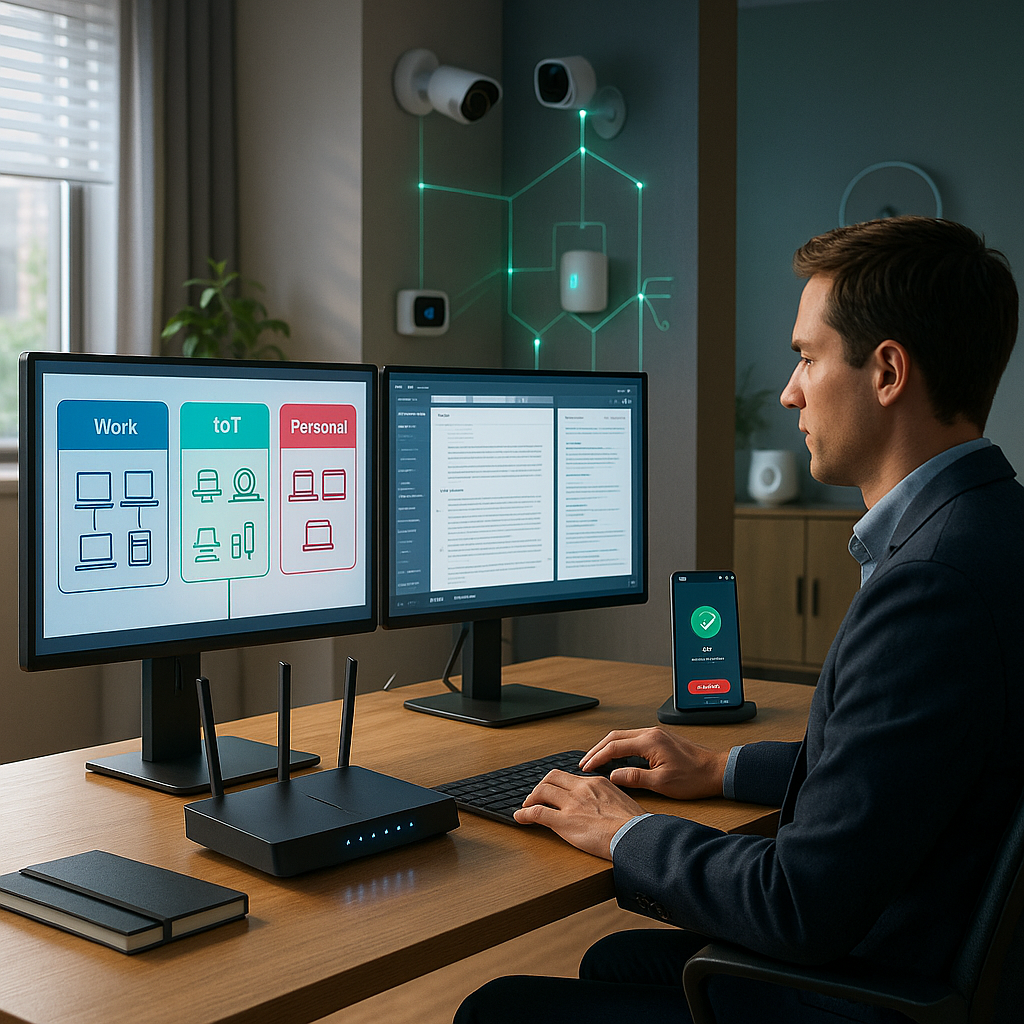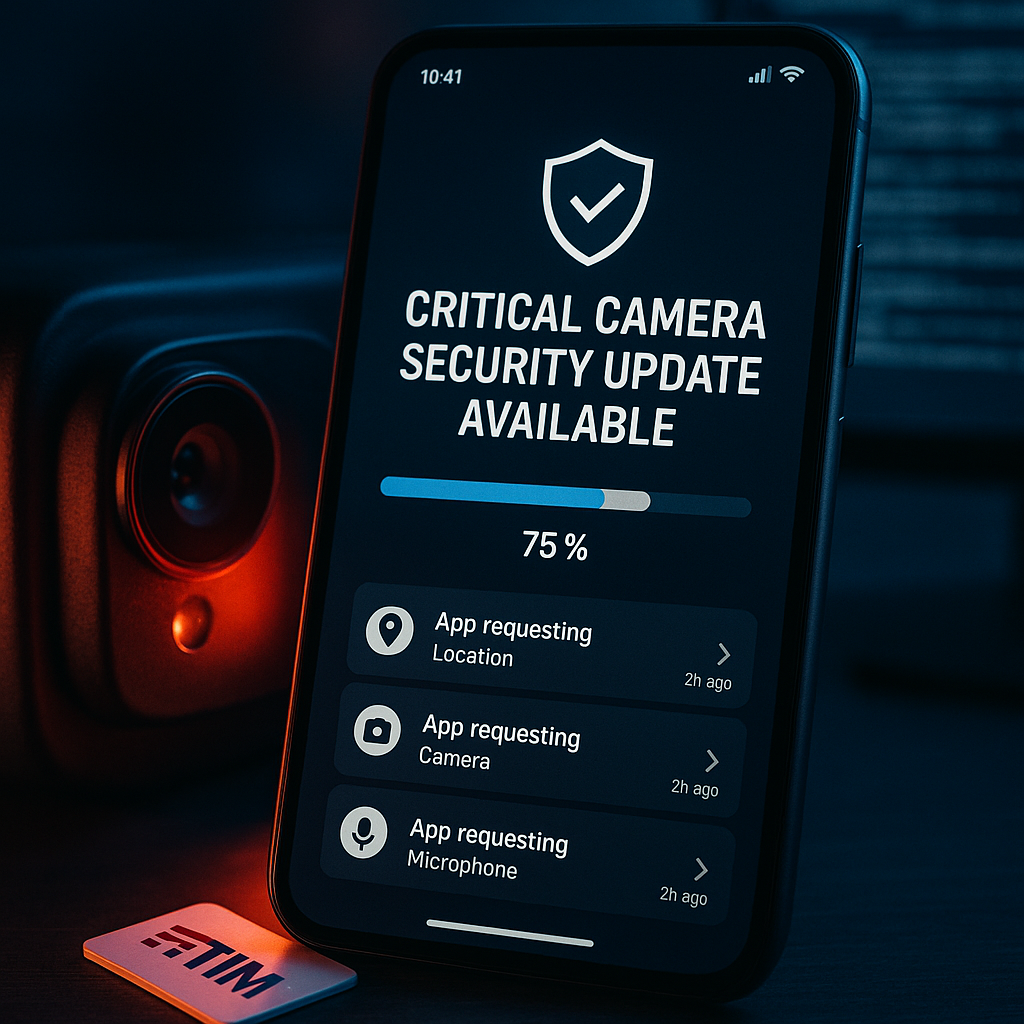Key Takeaways
- Smart home security is now a critical priority for remote workers juggling confidential business data and personal privacy, all while surrounded by internet-connected devices. This comprehensive guide offers actionable strategies designed specifically for the unique security challenges faced by remote professionals. These approaches ensure both your work and home environments remain protected.
- Create digital boundaries with separate networks. Set up dedicated WiFi networks for work and personal devices to isolate business data from smart home traffic. This approach minimizes cross-device vulnerabilities and helps keep sensitive information secure.
- Shield smart devices from cyber threats. Regularly update firmware, disable unnecessary features, and change default passwords on all IoT devices to guard against common attacks targeting smart home technology.
- Protect data on every connection with VPNs. Use a trusted VPN for remote work and for sensitive home technology. This encrypts your internet traffic and provides an extra layer of protection alongside your home network.
- Automate security with smart protocols. Take advantage of automated device scans, security alerts, and scheduled firmware updates to proactively detect and address security issues before they escalate.
- Achieve privacy without sacrificing usability. Balance convenience and control by conducting regular app permission audits, disabling always-on microphones and cameras, and using locally managed hubs (such as Zigbee) where possible for greater data sovereignty.
- Confidently manage the overlap between work and home technology. Tackle the distinctive challenge remote workers face by evaluating which devices genuinely require interconnection. Reducing unnecessary integration lowers risk, while prioritizing security for high-value systems ensures robust protection.
Equipped with these focused takeaways, you can implement smart, practical changes to reinforce the safety of both your workplace and home technology. Ready to see how you can turn your smart home office into a secure, seamless fortress that does not compromise on convenience or productivity? Let’s dive in.
Introduction
Your laptop is only one potential entry point for cyber risks in your workday. Every smart light, security camera, and connected speaker in your home office represents a doorway that could be targeted by cyber threats. This is especially significant when your living space doubles as your professional workspace. For remote workers, smart home security extends far beyond having strong passwords. It encompasses creating intentional digital boundaries that safeguard both sensitive business data and your personal privacy, even as your home becomes increasingly populated with connected devices.
Balancing the demands of remote work with the convenience of home life requires a thoughtful approach to protection. With effective smart home security strategies, you can secure IoT devices, shield your network, and protect both your career and household. The following practical steps will help transform your home office into a secure hub, allowing you to work and relax with confidence.
Setting Up a Secure Smart Home Office
Before you can maintain strong security, you need an infrastructure that supports separation and minimizes risk.
Un passo avanti. Sempre.
Unisciti al nostro canale Telegram per ricevere
aggiornamenti mirati, notizie selezionate e contenuti che fanno davvero la differenza.
Zero distrazioni, solo ciò che conta.
 Entra nel Canale
Entra nel Canale
Network Segmentation Essentials
Creating distinct network zones is an essential strategy for remote workers who rely on an array of smart home devices. Much like having separate rooms in a house, network segmentation keeps work devices isolated from potentially vulnerable IoT gadgets. This reduces the risk of cross-contamination if one device is compromised.
To implement effective segmentation, set up three primary networks:
- Work Network: Reserved strictly for your professional devices such as laptops, desktops, and essential peripherals.
- IoT Network: Dedicated to smart home devices like cameras, thermostats, lights, and voice assistants.
- Personal Network: For family members’ devices and entertainment systems.
Modern mesh Wi-Fi solutions, such as the TP-Link Deco X60 or Netgear Orbi, make assigning multiple SSIDs and customizing security policies straightforward. Research shows remote workers who implement segmented networks experience up to 30% fewer security incidents. This makes it an indispensable best practice not only for home offices but also for tech-laden households.
Securing Your Router Settings
Your router operates as the primary control point for your home network. Strengthening its settings can prevent up to 85% of common network breaches. Apply these foundational security measures:
- Change default admin credentials to a strong, unique password.
- Enable the highest encryption available, preferably WPA3, but at minimum WPA2-AES.
- Disable remote management features unless they are absolutely necessary.
- Set up a guest network for short-term devices and visitors so they do not gain access to your main networks.
- Keep the router’s firmware up to date. Schedule monthly checks or activate automatic updates if supported.
Following these steps builds a robust barrier against unauthorized access and helps create a trusted foundation for all your connected devices.
Smart Device Protection Protocols
Protecting smart devices involves several layers of proactive management:
Firmware Management
- Enable automatic updates on all devices, where possible.
- Manually check and update firmware monthly for devices lacking auto-update features.
- Maintain a shared update schedule using a digital calendar or task manager to avoid lapses.
Access Control
- Assign unique, strong passwords to every device.
- Activate two-factor authentication (2FA) for devices and platforms that offer it.
- Periodically audit all connected devices. Remove outdated or unused devices to reduce your risk footprint.
For added peace of mind, consider smart plugs with energy monitoring or home security hubs that allow you to remotely disable and monitor device access.
These practices do not only apply in the residential space. Small businesses and even educational institutions can benefit from adopting similar protocols to safeguard digital assets.
Managing Work-Life Security Boundaries
Building a truly secure smart home office requires more than just securing devices; it hinges on thoughtful separation of your digital and physical environments.
Creating Digital Zones
Divide your living space into distinct digital zones to reduce the likelihood of accidental vulnerabilities:
Work Zone Configuration
- Arrange work equipment away from always-listening smart speakers or voice assistants.
- Temporarily disable or mute smart displays and cameras during confidential meetings and video calls.
- Schedule smart device automation to match work hours, preventing interruptions or unintentional privacy risks.
Personal Space Setup
- Dedicate specific areas of your home as “tech-free” zones, particularly for private or sensitive conversations.
- Program smart devices to respect your set working hours.
- Configure motion detection and surveillance zones to exclude areas where business activity takes place.
This approach not only elevates security but also provides healthy boundaries, reducing digital fatigue and improving work-life balance. Honestly, having a clear line between work and personal life is helpful for more than just cybersecurity.
Automated Security Protocols
Automation brings efficiency and consistency to your security practices. By embedding security into your daily routines, you reduce the risk of lapses:
Un passo avanti. Sempre.
Unisciti al nostro canale Telegram per ricevere
aggiornamenti mirati, notizie selezionate e contenuti che fanno davvero la differenza.
Zero distrazioni, solo ciò che conta.
 Entra nel Canale
Entra nel Canale
- Morning Security Routine
- Automatic VPN activation on work devices before accessing sensitive data.
- Verification of smart lock status to ensure the premises are secure.
- Activation of security cameras or privacy shutters in non-work areas.
- Evening Shutdown Protocol
- Restrict network access after business hours for work devices and critical systems.
- Run automated device audits and system scans to ensure no anomalies are present.
- Activate overarching security systems for overnight protection.
By leveraging tools such as IFTTT, Home Assistant, or even built-in features of smart home hubs, you can streamline these routines for maximum effect.
Advanced Security Measures
Once the basics are in place, adopting advanced security tactics further strengthens your defense.
Cloud Integration Security
With remote work often requiring cloud-based tools, safeguarding cloud integrations is vital across sectors, from healthcare to finance and education.
Storage Solutions
- Rely on end-to-end encrypted cloud services for sensitive files.
- Implement automatic, scheduled backups to avoid accidental data loss.
- Always keep personal and professional cloud accounts separate.
Access Management
- Activate location-based authentication to restrict access to authorized geographies.
- Use hardware security keys (such as Yubico or Google Titan) for highly sensitive accounts.
- Regularly audit app permissions and third-party app connections to your cloud accounts.
This extra layer of management applies to any field leveraging cloud services, including legal (for contract management) and healthcare (for patient records).
Monitoring and Response Systems
Comprehensive monitoring dramatically increases your ability to detect and mitigate threats:
Network Monitoring
- Deploy intrusion detection and prevention systems tailored for home and small office environments.
- Monitor bandwidth patterns for sudden changes that could signal compromised devices.
- Set up real-time alerts for unauthorized device behavior or unusual access attempts.
Smart Device Tracking
- Log every device access attempt for forensic investigation if an incident occurs.
- Consistently monitor the communications of IoT devices and review logs for red flags.
- Track firmware update status to ensure no device lags behind on security patches.
A recent cross-industry case study found that home offices using such monitoring measures could detect and prevent up to 94% of security breaches before data was compromised. These practices can be easily extended to retail environments, small businesses, and even nonprofit organizations that depend on smart technology but lack dedicated IT teams.
Privacy Considerations
While maintaining security is critical, you must also protect personal and work-related privacy to avoid both data leakage and invasive surveillance.
Data Protection Strategies
Keeping your data private requires conscious policies:
Smart Device Settings
- Proactively disable features and sensors you do not use, such as cameras or microphones when not needed.
- Schedule monthly privacy reviews to check and adjust settings as device software evolves.
- Opt for local (on-device) processing for personal data whenever possible instead of automatic cloud uploads.
Work Data Protection
- Encrypt all files containing sensitive business data.
- Use privacy screen filters during meetings or while working in shared spaces to prevent shoulder surfing.
- Schedule regular access audits, reviewing who can reach sensitive data. This is especially relevant in health and legal fields where data privacy is regulated.
These steps are especially valuable in sectors like education and finance, where client confidentiality and regulatory compliance are paramount.
Managing Voice Assistant Security
Voice assistants add convenience but also new privacy considerations:
- Adjust wake word sensitivity to avoid accidental activation.
- Routinely retrain the assistant’s voice recognition for greater accuracy.
- Schedule “quiet hours” to disable listening features during sensitive conversations or meetings.
- Set recurring reminders to review and delete recorded voice histories.
Consistently practicing these steps can reduce privacy incidents by up to 75%, allowing you to benefit from hands-free productivity features without compromising security.
Conclusion
Building a secure smart home office is about much more than strong passwords. It involves intentional digital boundaries, robust routines, and the strategic use of technology to minimize risk while sustaining productivity and comfort. By segmenting your networks, fortifying your router settings, and enforcing disciplined access controls, you insulate your professional devices from the vulnerabilities found in consumer-grade IoT ecosystems.
Harnessing automation and advanced monitoring adapts your defense to daily routines, ensuring continuous protection without imposing extra burdens. Thoughtful cloud storage and privacy management, combined with regular device and permission audits, make it possible to preserve both data sovereignty and seamless usability.
Ultimately, a secure smart home office provides the freedom to thrive in today’s connected world, whether you are closing deals, attending virtual appointments, or helping children with homework. As remote work and digital living continue to converge, those who innovate their approach to security (staying proactive, adaptable, and informed) will have the confidence and resilience to excel in any environment. The next chapter in smart home evolution belongs to individuals and organizations that prioritize both safety and simplicity. The challenge is not only to implement these advancements, but to leverage them in creating spaces that are as productive as they are protected.





Leave a Reply